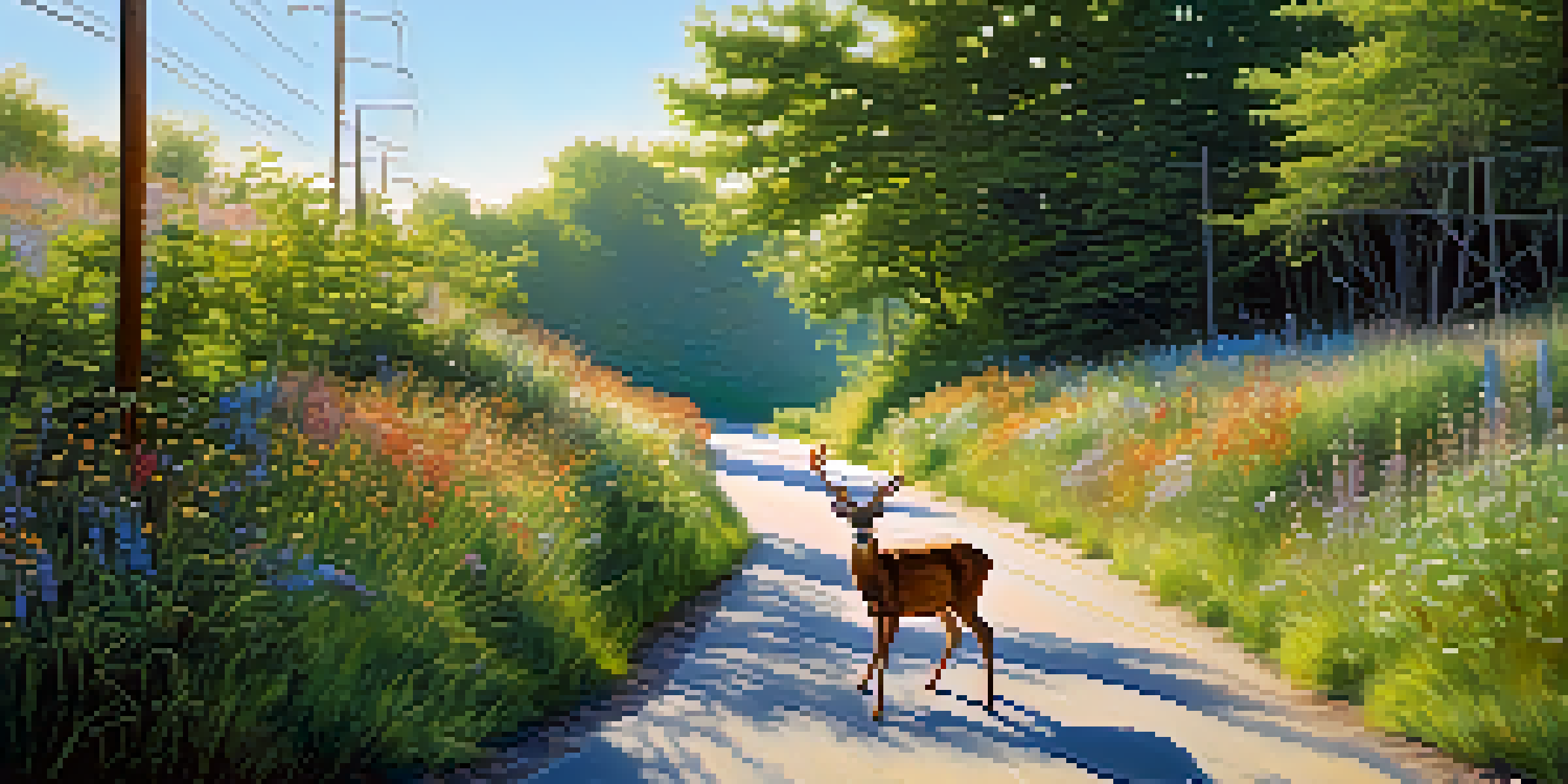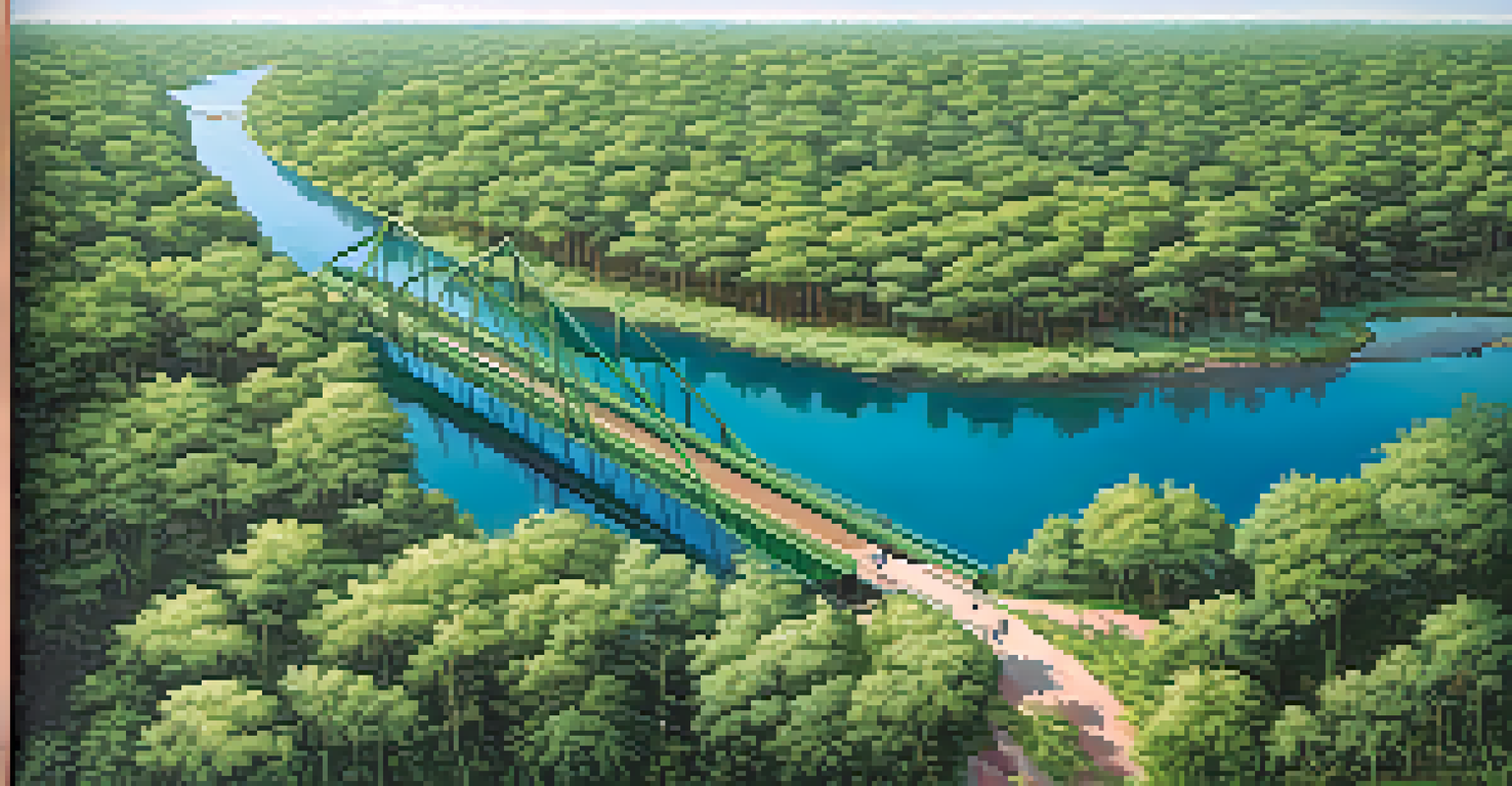Wildlife Corridors: Ensuring Safe Passage for Animals

What Are Wildlife Corridors and Why Do They Matter?
Wildlife corridors are designated routes that allow animals to move safely between habitats. These pathways are crucial, especially in areas where urban development or agriculture has fragmented natural landscapes. By providing safe passages, these corridors support biodiversity and help maintain healthy ecosystems.
Wildlife corridors are essential for maintaining biodiversity and ensuring the survival of many species in a rapidly changing world.
Imagine a highway for animals, where they can travel without the threat of vehicles or barriers disrupting their journey. This is particularly important for species that migrate or need to find mates, food, or new territories. Without these corridors, animals may struggle to survive, leading to reduced populations and even extinction.
Ultimately, wildlife corridors serve as lifelines for many species, ensuring genetic diversity and resilience against environmental changes. They play a significant role in conservation efforts and help us maintain the delicate balance of nature.
The Impact of Urbanization on Animal Movement
As cities expand, natural habitats are often destroyed or divided, making it challenging for wildlife to navigate their surroundings. Roads, buildings, and other human-made structures can act as barriers, isolating animal populations and disrupting their natural behaviors. This fragmentation can lead to increased roadkill and a decline in species numbers.

For example, think of the common deer. When their migration routes are cut off by highways, they may venture into urban areas, increasing the chances of dangerous encounters with vehicles. This not only poses a risk to the animals but also to drivers and pedestrians.
Wildlife Corridors Enhance Survival
These designated routes allow animals to safely navigate fragmented habitats, supporting biodiversity and ecosystem health.
By understanding the impact of urbanization, we can advocate for the creation of wildlife corridors that mitigate these risks. These corridors can help reconnect habitats, allowing animals to thrive even in areas heavily influenced by human activities.
Types of Wildlife Corridors and Their Functions
There are various types of wildlife corridors, each serving unique purposes. Some are linear pathways, such as overpasses or underpasses, specifically designed to facilitate animal movement across roads. Others may include broader areas of land that connect larger ecosystems, allowing multiple species to migrate safely.
Conservation is a state of harmony between men and land.
For instance, green bridges and tunnels are effective solutions that have been implemented in many regions. These structures not only allow animals to cross but also provide vegetation that mimics their natural habitat, making them feel more at ease while traversing these areas.
Each type of corridor plays a vital role in preserving wildlife populations and their habitats. By considering the specific needs of different species, we can design corridors that enhance their chances of survival in our ever-changing world.
Successful Examples of Wildlife Corridors in Action
Successful wildlife corridors can be seen around the globe, showcasing how effective they can be. For example, the Banff Wildlife Crossings in Canada feature a series of overpasses and underpasses that have dramatically reduced wildlife-vehicle collisions. These crossings have allowed species such as bears and elk to move freely while keeping both animals and drivers safe.
In the United States, the Florida Wildlife Corridor is a groundbreaking initiative aimed at connecting fragmented habitats across the state. This ambitious project not only helps protect endangered species like the Florida panther but also preserves the ecological integrity of the area.
Urbanization Threatens Animal Movement
As cities expand, natural habitats are disrupted, making it crucial to create corridors to mitigate risks for wildlife.
These examples highlight the importance of collaboration between governments, conservation organizations, and local communities. By working together, we can create effective solutions that benefit both wildlife and humans.
Challenges in Implementing Wildlife Corridors
While the concept of wildlife corridors is promising, several challenges can hinder their implementation. One major hurdle is securing funding for construction and maintenance, as these projects often require significant investment. Additionally, land ownership and usage rights can complicate the establishment of corridors, especially in densely populated areas.
Moreover, there is often a lack of public awareness or support for wildlife corridors, which can slow down progress. Many people may not understand the benefits these corridors provide or how they can contribute to conservation efforts.
To overcome these challenges, it's essential to communicate the importance of wildlife corridors effectively. By raising awareness and advocating for funding, we can help ensure these vital pathways are established and maintained for future generations.
The Role of Technology in Wildlife Corridor Design
Advancements in technology have significantly enhanced the planning and design of wildlife corridors. Tools such as Geographic Information Systems (GIS) allow researchers to analyze animal movement patterns and habitat connectivity. This data-driven approach helps identify the most effective locations for corridors to be established.
Additionally, wildlife cameras and tracking devices enable scientists to monitor animal behavior and usage of these corridors. This information is crucial for assessing the effectiveness of existing corridors and making improvements where necessary.
Community Support is Essential
Local involvement is vital for advocating and monitoring wildlife corridors, fostering a sense of ownership and responsibility.
By leveraging technology, we can create smarter, more efficient wildlife corridors that cater to the specific needs of various species, ultimately aiding in their survival.
Community Involvement in Wildlife Corridor Initiatives
Community involvement is vital for the success of wildlife corridor initiatives. Local residents can play an essential role in advocating for the creation of these pathways and can help monitor their effectiveness. By working together, communities can raise awareness about the importance of wildlife corridors and engage in conservation efforts.
For example, community workshops and educational programs can inform residents about the benefits of wildlife corridors and encourage them to participate in conservation activities. This grassroots approach fosters a sense of ownership and responsibility toward local wildlife.

When communities unite for a common cause, they can create lasting change. Together, we can ensure that wildlife corridors not only exist but thrive, providing safe passage for animals for years to come.
The Future of Wildlife Corridors and Conservation
Looking ahead, the future of wildlife corridors and conservation appears promising, but it requires ongoing commitment and innovation. As climate change and habitat loss continue to threaten wildlife, establishing and maintaining corridors will be crucial for species survival. We must continue to adapt our strategies to address emerging challenges and protect biodiversity.
Moreover, integrating wildlife corridors into urban planning and development can create a balance between human needs and wildlife conservation. By prioritizing green spaces and connectivity in our cities, we can create environments that support both people and wildlife.
Ultimately, the success of wildlife corridors relies on collaboration among governments, organizations, and individuals. Together, we can pave the way for a future where wildlife can thrive alongside us, ensuring a harmonious coexistence with nature.